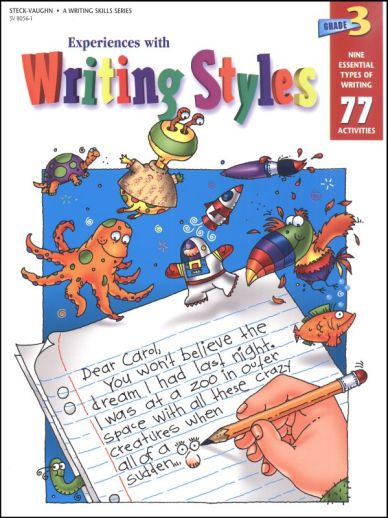We use cookies to make your experience better. To comply with the new e-Privacy directive, we need to ask for your consent to set the cookies. Learn more.
Experiences with Writing Styles Grade 3
These materials contain both instruction and writing assignments but are not as broad in scope (types of writing) as the comprehensive programs.
Are you looking for a quick and easy writing program to use along with, say, Learning Language Arts Through Literature in between the writing units? We've been there! Or, are there times when your time and energies aren't stretching far enough? Me too! Many of us like to have our students practice writing every day, but there are days when our instructional time is limited. Few programs are available that can be used independently by elementary-aged children in this circumstance. Here is one. These books contain 9-10 short writing units which concentrate on a particular type of writing. Both creative and expository forms are included. It's solid, it's fairly self instructional, and it is more than just a book full of writing prompts, containing not just ideas, but "how to's". Each unit provides practice in all five stages of the writing process: pre-writing, drafting, responding and revising, proofreading, and publishing. The writing units are different at each level. My sample for grade 4 contains the following: Personal Narrative, Information Paragraph, Friendly Letter, How-to Paragraph, Descriptive Paragraph, Fable, Persuasive Paragraph, Research Report and Paragraphs of Comparison and Contrast. Each unit is similarly organized. After a short assessment activity two lessons are provided for the thinking, or pre-writing, stage. The first generally requires students to read, then analyze, a provided sample by answering several questions about it. The second activity varies by unit and is intended to increase awareness of some aspect of the focal type of writing. The third lesson provides practice with writing style such as using vivid words, using metaphor and simile, including details, etc. Activities such as using the thesaurus, keeping to the topic, combining sentences, avoiding wordy language, etc. are included in a fourth activity designed to practice the revision stage of writing. The final lesson in each unit has students proofread a paragraph of the type they will be writing. After the lessons in the unit are completed, there are 3-5 writing prompts/worksheets to practice the form of writing just studied. I like this feature, also. You can use these in succession to really master the form before continuing or complete just one or two and use the rest for later writing experiences. An exercise answer key is included.
| Product Format: | Softcover Book |
|---|---|
| Brand: | Steck-Vaughn |
| Author: | Kathleen Fitzgibbon |
| Grade: | 3 |
| ISBN: | 9780817280567 |
| Length in Inches: | 11 |
| Width in Inches: | 8.5 |
| Height in Inches: | 0.25 |
| Weight in Pounds: | 0.35 |

